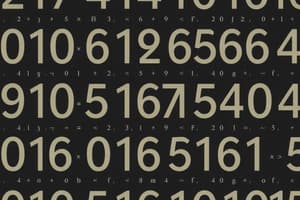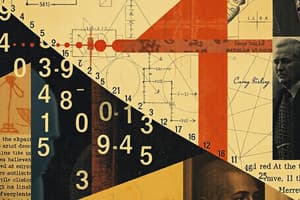Podcast
Questions and Answers
In the geometric sequence 2, 6, 18, 54, the common ratio is ____.
In the geometric sequence 2, 6, 18, 54, the common ratio is ____.
3
In the sequence 1, -2, 4, -8, the common ratio is ____.
In the sequence 1, -2, 4, -8, the common ratio is ____.
-2
The sixth term in the sequence 0, 4, 8, 12, 16, ____ is ____.
The sixth term in the sequence 0, 4, 8, 12, 16, ____ is ____.
20
In the sequence 3, -6, 12, ____, ____, -96, the missing term is ____.
In the sequence 3, -6, 12, ____, ____, -96, the missing term is ____.
The common ratio in the sequence 10, 5, ____, ____ is ____.
The common ratio in the sequence 10, 5, ____, ____ is ____.
A sequence is an ordered set of numbers formed according to some ______ or rule.
A sequence is an ordered set of numbers formed according to some ______ or rule.
The term _____ denotes the first element of a sequence.
The term _____ denotes the first element of a sequence.
An arithmetic sequence is a sequence where every term after the first term is obtained by adding a constant called the common ______.
An arithmetic sequence is a sequence where every term after the first term is obtained by adding a constant called the common ______.
In the sequence 1, 4, 7, 10, the fifth term is ______.
In the sequence 1, 4, 7, 10, the fifth term is ______.
The sequence with the common difference of -2, such as in 25, 23, 21, 19, is an example of a sequence with a ______ common difference.
The sequence with the common difference of -2, such as in 25, 23, 21, 19, is an example of a sequence with a ______ common difference.
For the sequence 4, 9, 14, 19, the seventh term is ______.
For the sequence 4, 9, 14, 19, the seventh term is ______.
The finite set of positive integers includes numbers such as 1, 2, 3, and ______.
The finite set of positive integers includes numbers such as 1, 2, 3, and ______.
The sequence of days in the calendar identified as 1, 3, 5, 7, has a missing term that is ______.
The sequence of days in the calendar identified as 1, 3, 5, 7, has a missing term that is ______.
Flashcards
Sequence
Sequence
An ordered set of numbers following a specific pattern or rule.
Arithmetic Sequence
Arithmetic Sequence
A sequence where each term after the first is found by adding a constant value (common difference).
Common Difference
Common Difference
The constant value added to each term in an arithmetic sequence to get the next term.
First term (a1)
First term (a1)
Signup and view all the flashcards
nth term (an)
nth term (an)
Signup and view all the flashcards
Geometric Sequence
Geometric Sequence
Signup and view all the flashcards
Pattern Recognition
Pattern Recognition
Signup and view all the flashcards
Identifying the next term in a sequence
Identifying the next term in a sequence
Signup and view all the flashcards
Geometric Sequence Definition
Geometric Sequence Definition
Signup and view all the flashcards
Common Ratio (Geometric Sequence)
Common Ratio (Geometric Sequence)
Signup and view all the flashcards
Finding the next terms in a Geometric Sequence
Finding the next terms in a Geometric Sequence
Signup and view all the flashcards
Example of Geometric Sequence
Example of Geometric Sequence
Signup and view all the flashcards
Finding the Common Ratio
Finding the Common Ratio
Signup and view all the flashcards
Study Notes
Introduction to Sequences
- Sequences are ordered sets of numbers following a pattern or rule.
- A sequence is a function where the domain is a set of positive integers or a finite subset of positive integers.
- Sequences are denoted by {an}.
Types of Sequences
-
Arithmetic Sequence: Each term after the first is found by adding a constant (common difference).
- Example: 1, 4, 7, 10... (common difference is 3).
- The fifth term in the sequence 1,4,7,10... is 13.
- The common difference in 3, 8, 13, 18... is 5. The fifth term is 23.
- The common difference in 25, 23, 21, 19 is -2. The fifth term is 17.
- The common difference in 4, 9, 14, 19... is 5. The seventh term is 34.
-
Geometric Sequence: Each term after the first term is obtained by multiplying the preceding term by a non-zero constant (common ratio).
- Example: 1, 3, 9, 27... (common ratio is 3).
- The fifth term in the sequence 1, 3, 9, 27... is 81.
- The common ratio in 2, 6, 18, 54... is 3. The fifth term is 162.
- The common ratio in 1, -2, 4, -8... is -2. The sixth term is 32.
- The common ratio in 10, 5, 2 1/2... is 1/2. The 6th term is 5/16.
Identifying Patterns in Sequences
- Identify whether a pattern exists in the sequence of numbers or objects.
- If a pattern is apparent, determine the next term or missing term(s) in the sequence.
Examples of Sequences to Study
- 1, 5, 8, 11, 14, 17... (arithmetic sequence)
- 9, 4, -1, -6, -11...(arithmetic sequence)
- 2, 1, 3/2, 2, 5/2 (arithmetic sequence)
- 3, -6, 12, -24, ..., -96... (geometric sequence)
- 3/7, -6/35, 12/175.. (geometric)
- 12, 9, 27/4... (arithmetic sequence)
Studying That Suits You
Use AI to generate personalized quizzes and flashcards to suit your learning preferences.




